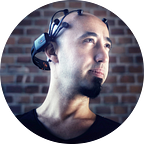Academic Work
For my MSc. degree in Electronics Engineering, I’ve implemented a BCI system which helps locked-in patients, e.g., ALS patients, type with their brain signals. Later, I’ve upgraded the system to use Emotiv, a wireless electrode headset.
This is a sum up of my academic work.
Introduction
What’s a Brain-Computer Interface?
A brain computer interface is a system that enables users to control a computer (or another device with the help of a computer) by using their brain signals.
Although there are various types of BCI implementations, the basic scheme is always true. We’ll go into details of an EEG (electroencephalography) based BCI but other systems such as MEG are also available.
In an EEG based BCI, the electrical activity in the user’s brain is captured by little devices called electrodes which are attached to various places on the user’s head.
These signals are then fed to a computer. The computer analyzes these signals, and decides what to do with them. This might be controlling a robot arm, or using a mouse. In my area of interest, the computer lets the user type.
Based on the analysis, an output information might be displayed on a screen so that the user knows the result of his actions.
On some BCI applications, visual or auditory feedback is given to the user in realtime, of which a BCI mouse is a good example.
There are many techniques for obtaining electrical information from the brain. One might use the frequency spectrum, spectral power, amplitudes or actual patterns of acquired signals.
Some BCI applications might require the user to realize an action, such as lifting a finger or rolling an eye, while some others just require the user to think doing so.
What is a P300 Speller?
A P300 speller is a BCI implementation where acquired brain signals allow the user to type into the computer.
The user is presented with a matrix of letters and/or symbols that flash in a random order; and is asked to count the number of flashes of a specific letter/symbol. A special signal pattern called the P300 occurs in the brain in the process; hence the name.
Checkout the videos below to see how the system works.
BCI Videos
The world’s fastest* academic P300 speller
This is the fastest implementation of a P300 speller system ever published in an academic work up to 2010, and has been published in various conference proceedings by Armagan Amcalar and Mujdat Cetin.
Posting status updates to Facebook and Twitter with EEG
Below are a couple of videos where I post status updates to Facebook and Twitter. Sorry for the horrible quality!
There are no hidden keyboards or any other controller involved! All the letters, correct and wrong, are spelled by thought.
Here is the Twitter link of the status update posted in this video.
This is my previous attempt, where I forgot to implement the Enter key :) Although it’s quicker and error-free, I do not count this as a complete success as I still had to click Enter manually.
Here is the famous quote “Ne Mutlu Türküm diyene!” by Mustafa Kemal Ataturk, founder of modern Turkey that praise being a Turk.
I wanted to type the url of this video again at the end, but I failed and typed Enter instead of the second /, therefore the post appeared thus in my Twitter and Facebook account :)
Videos are recorded on Jan 7th, 2010 at Sabanci University.
